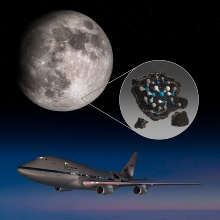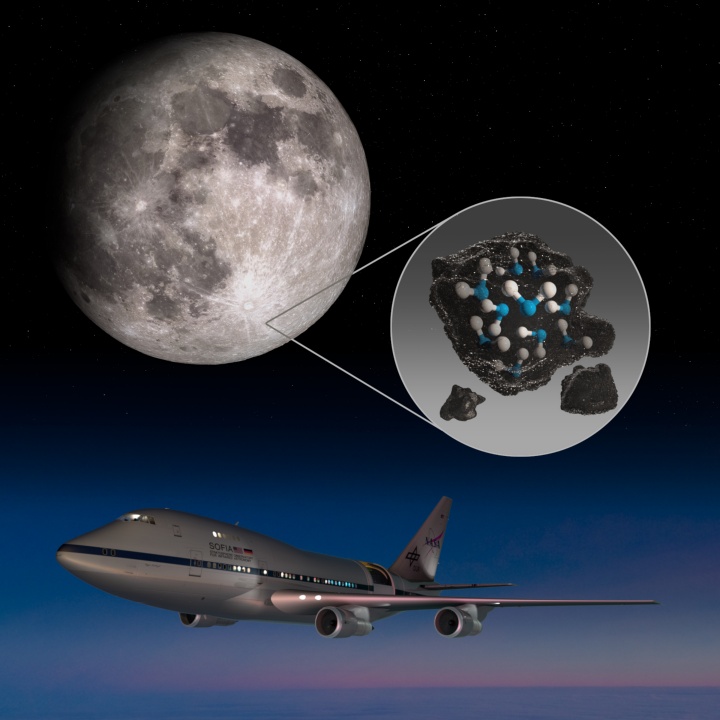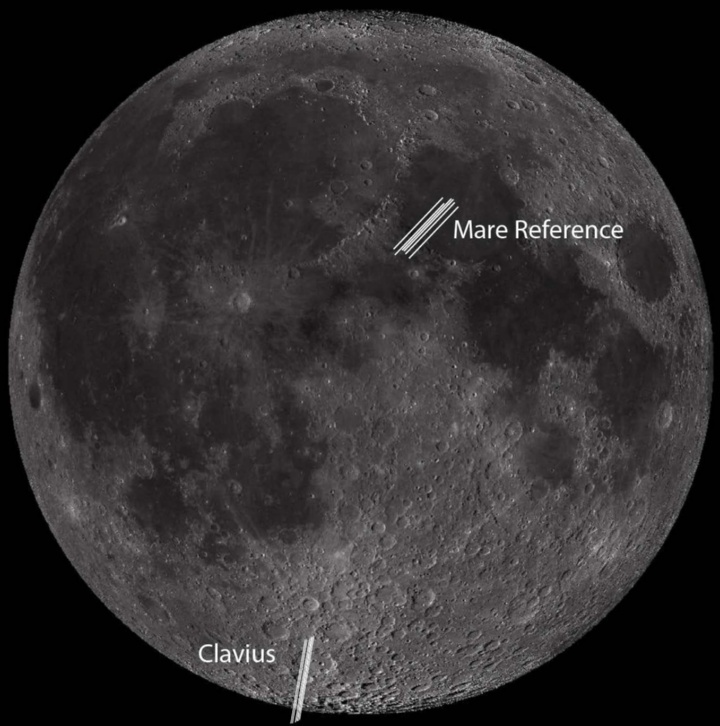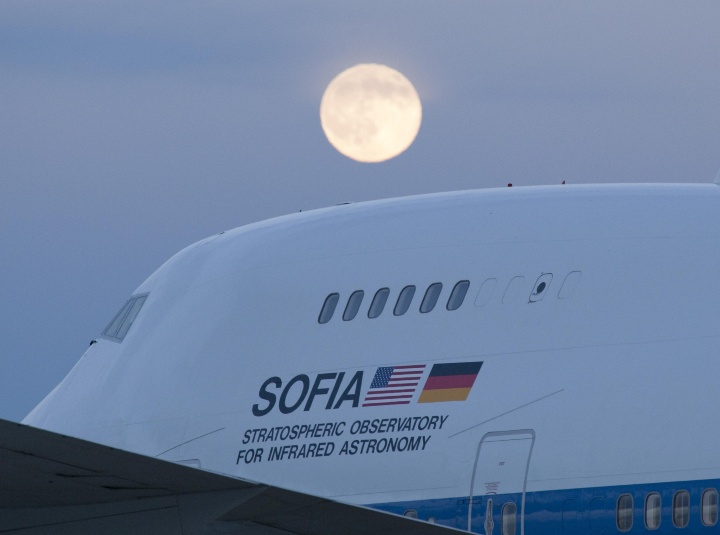For the first time, the airborne observatory SOFIA (Stratospheric Observatory for Infrared Astronomy) has provided direct unambiguous evidence of water molecules on the Moon outside the permanent shadow at the Moon's poles. The infrared observatory of the U.S. space agency NASA and the German Aerospace Center (DLR) succeeded in detecting the molecules in the southern hemisphere of the Moon with the FORCAST (Faint Object InfraRed CAmera for the SOFIA-Telescope) instrument. The results of the scientific research work were published in the scientific journal Nature Astronomy on October 26th, 2020. SOFIA’s scientific operation is coordinated on the German side by the German SOFIA Institute (DSI) at the University of Stuttgart.

Since the Apollo 11 mission in 1969 brought the first lunar rocks to Earth, researchers have been searching for the unequivocal proof that there is water on the Moon. However, the samples from this mission - as well as those from the numerous follow-up missions - did not show any clear evidence of the existence of water on the Earth's satellite. Confirmation, at least for the region around the Moon's poles, finally came through the NASA instrument Moon Mineralogy Mapper on board the Indian Chandrayaan-1 mission in 2009. "With SOFIA, we have finally been able to provide the long-awaited, unequivocal proof that water also exists on the warmer, sunlit lunar surface," explains Bernhard Schulz, SOFIA Science Mission Operation Deputy Director of the University of Stuttgart. A team led by Casey Honniball from the Hawaiian Institute of Geophysics and Planetology had already observed the Moon with the FORCAST instrument on board SOFIA on August 30th, 2018. They were able to detect the unique fingerprint of molecular water in the mid-infrared range (six micrometers wavelength) near the Clavius crater in the Moon’s southern hemisphere.
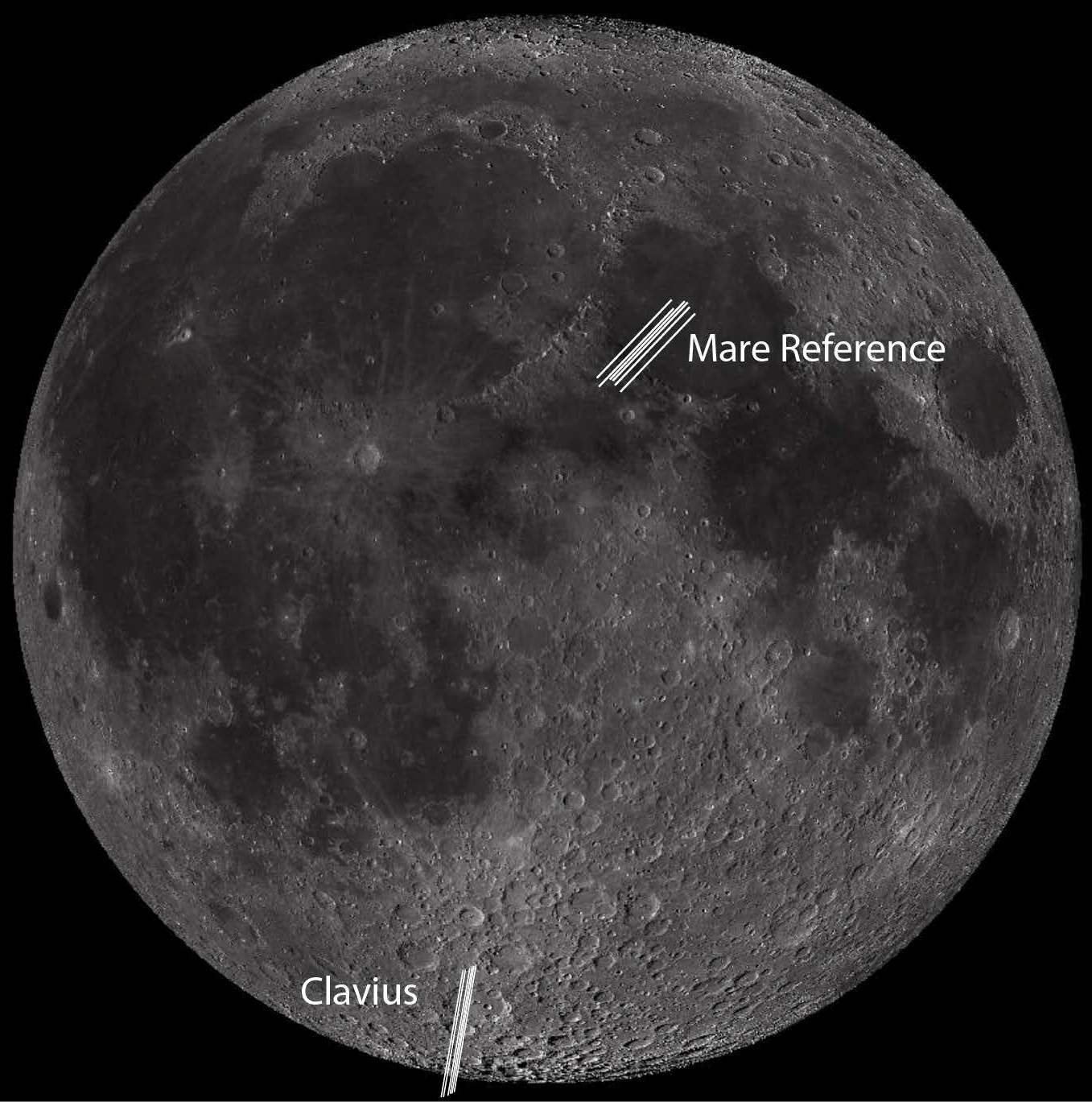 Image of the Moon with the slits above the Clavius crater and the Mare reference. Credits: Honniball et al 2020.
Image of the Moon with the slits above the Clavius crater and the Mare reference. Credits: Honniball et al 2020.
How Does Water Come to the Moon?
The sunlit areas of the Moon reach a temperature of about 230 degrees Celsius. At this temperature, water is gaseous and should evaporate, since the Moon has virtually no atmosphere. Nevertheless, water is present on the surface. Currently there are two theories that can explain this: One theory is that Micrometeorites that fall on the Moon's surface and transport small amounts of water could deposit the liquid in the rock at impact, so that the water then remains trapped in the ground in tiny glass-bead-like structures. However, water could also be brought to the Moon through a two-stage process in which solar wind delivers hydrogen to the lunar surface, where it combines with hydroxyl (HO) - a hydrogen atom bonded to an oxygen atom - to form water. This water could percolate on the surface of the Moon and would thus be protected from sunlight.
Water as the Basis for Future Space Missions
One aim of European space research on the Moon, which is largely co-financed by Germany, is to confirm that resources such as water are available on the Moon in sufficient quantities to be able to use them, for example, for a future "Moon village". The amount of water discovered by SOFIA is roughly equivalent to the content of a 0.33 Liter beverage can, distributed in one cubic meter of soil. "That's less than in the deserts of our Earth," explains Reinhold Ewald, European astronaut and professor at the Institute of Space Systems (IRS) at the University of Stuttgart. "But resourceful life-support systems such as those we are developing and researching in the field of astronautics and space stations at the IRS could produce some of the resources we will need for future astronautical space missions.”
To explore the phenomenon of water on the Moon in more detail, SOFIA will observe the sunlit areas during different phases of the Moon. The scientists hope that this will provide new insights into how water is produced and stored and how it is distributed across the lunar surface. These data will be helpful for planning future lunar missions.
Original Publication:
Molecular water detected on the sunlit Moon by SOFIA, C. I. Honniball et al., Nature Astronomy, 26. Oktober 2020
(DOI: 10.1038/s41550-020-01222-x)
Links zur News:
- Video: NASA-Animation Credits: NASA & USRA
- Video: German Version
Credits: NASA & USRA (Video material), 3M2 Film (German Editing) -
Participate in a Reddit Ask Me Anything on our Moon exploration activities at 1 p.m. EDT / 6pm MEZ Tuesday, Oct. 27:
http://reddit.com/r/space - Pressemitteilungen
Professional Contact:
Prof. Dr. Alfred Krabbe, Deutsches SOFIA Institut at the Institute of Space Systems of the University of Stuttgart, Phone.: +49 711 685-62406, E-Mail krabbe@dsi.uni-stuttgart.de
Dr. Casey I. Honniball (author), Ph.D., NASA Post-Doctoral Program Fellow, NASA Goddard Space Flight Center, E-Mail: cih@higp.hawaii.edu
Press Contact:
Dörte Mehlert, University of Stuttgart, Deutsches SOFIA Institut,
Phone: +49 711-685-69632, E-Mail: mehlert@dsi.uni-stuttgart.de
Further SOFIA Links
- SOFIA Science Center
- NASA SOFIA Missions Page
- SOFIA Missions Page of DLR
- DLR SOFIA Projekt Page
- DLR Blogs for SOFIA
SOFIA, the "Stratospheric Observatory for Infrared Astronomy" is a joint project of the Deutsches Zentrum für Luft- und Raumfahrt e.V. (DLR; German Aerospace Center, grant: 50OK0901, 50OK1301 and 50OK1701) and the National Aeronautics and Space Administration (NASA). It is funded on behalf of DLR by the Federal Ministry for Economic Affairs and Energy based on legislation by the German Parliament, the State of Baden-Württemberg and the University of Stuttgart. Scientific operation for Germany is coordinated by the German SOFIA-Institute (DSI) of the University of Stuttgart, in the USA by the Universities Space Research Association (USRA).
About Lufthansa Technik
With some 35 subsidiaries and affiliates, the Lufthansa Technik Group is one of the leading providers of technical aircraft services in the world. Certified internationally as maintenance, production and design organization, the company has a workforce of more than 25,000 employees. Lufthansa Technik’s portfolio covers the entire range of services for commercial and VIP/special mission aircraft, engines, components and landing gear in the areas of digital fleet support, maintenance, repair, overhaul, modification, completion and conversion as well as the manufacture of innovative cabin products.


